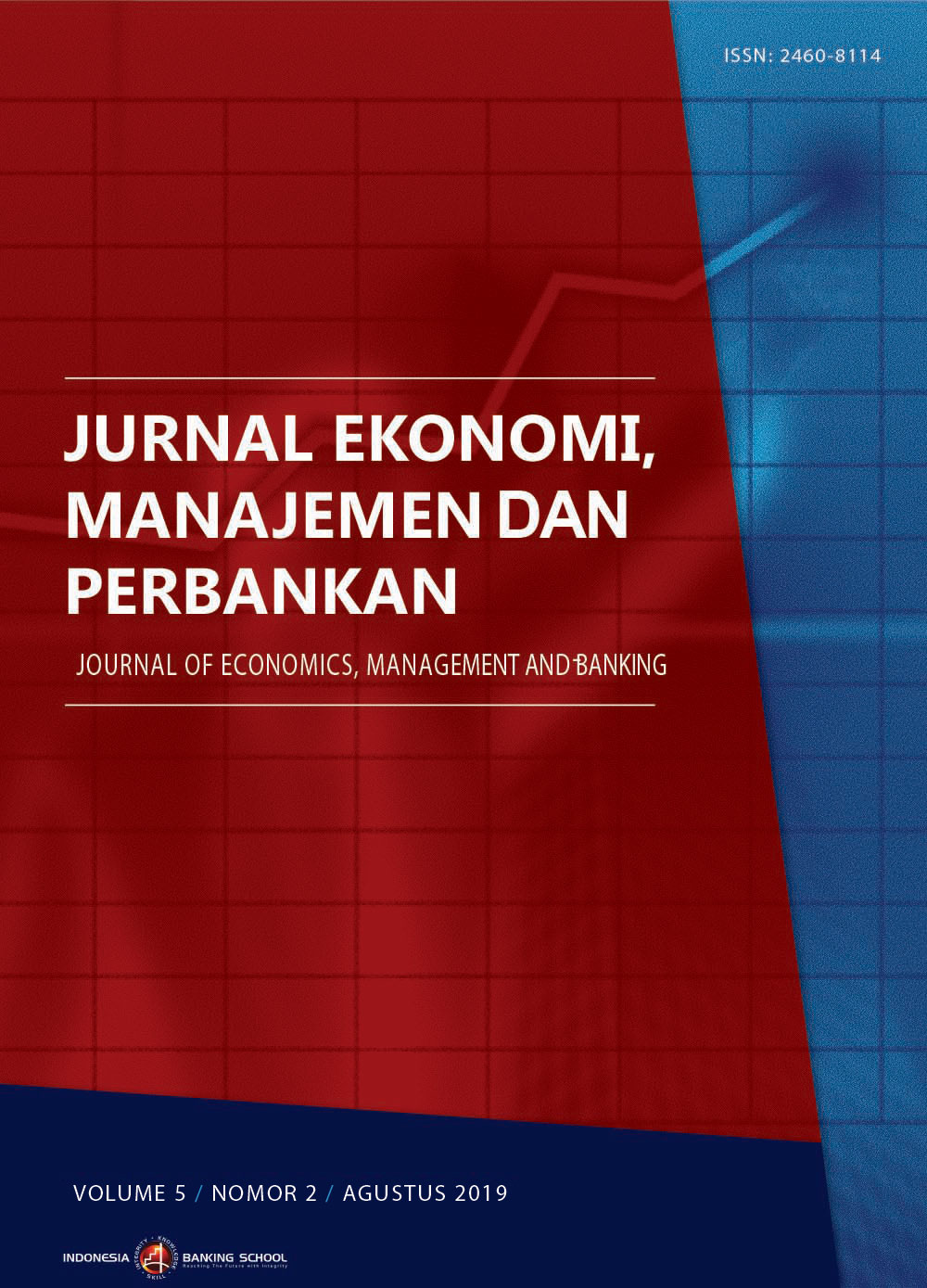Analisis Faktor-Faktor Yang Mempengaruhi Persepsi Pengguna E-Payment (Studi Empiris Terhadap Pengguna Gopay Dan OVO Di DKI Jakarta Dan Depok)
DOI:
https://doi.org/10.35384/jemp.v5i2.244Keywords:
Persepsi kemudahan penggunaan, persepsi manfaat, kepercayaan, keamanan, Gopay, OVO, elec-tronic payment system, point of saleAbstract
Penelitian ini bertujuan untuk menganalisis faktor-faktor yang memengaruhi persepsi penggunaan e-payment. Objek penelitian ini adalah para pengguna Gopay dan OVO yang berlokasi di DKI Jakarta dan Depok. Penelitian ini dilakukan terhadap 112 responden, data yang digunakan dalam penelitian ini adalah data primer dan pengumpulan data digunakan menggunakan kuesioner melalui Google Form dengan metode convenience sampling dan purposive sampling. Hasil penelitian menunjukan bahwa persepsi kemudahan penggunaan & persepsi manfaat berpengaruh positif terhadap persepsi pengguna dalam menggunakan e-payment sedangkan kepercayaan & keamanan tidak berpengaruh terhadap persepsi pengguna dalam menggunakan e-payment.References
Alyabes, A. F., & Alsalloum, O. (2018). Factors Affecting Consumers’ Pro-environmental Be-haviours in Saudi Arabia. European Journal of Business and Management, 10(27), 303–314.
Ayo, C. K., & Ukpere, W. I. (2010). Design of a secure unified e-payment system in Nigeria: A case study. African Journal of Business Man-agement, 4(9), 1753–1760.
Bahri, S. (2016). Penerapan Sistem Pembayaran Secara Elektronik Pada Point Of Sales ( P . O . S ) Berbasis Near Field Communication ( NFC ) Seminar Nasional Ilmu Pengetahuan dan Teknologi Komputer Nusa Mandiri, 258–262.
Cania, S. C. (2018). Faktor-Faktor Yang Mempengaruhi Penggunaan Layanan GoPay Pada Pelanggan Maupun Pengemudi GoJek.
Davis, F. (1989). Perceived Usefulness, Perceived Ease of Use, and User Acceptance of Infor-mation Technology. MIS Quarterly, 13(3), 319–340.
Davis, F. D., Bagozzi, R. P., & Warshaw, P. R. (1989). User Acceptance of Computer Tech-nology: A Comparison of Two Theoretical Models. Management Science, 35(8), 982–1003.
Faqih, A. (2018). Kajian Uang Elektronik dalam Perspektif Undang-Undang Perlindungan Konsumen dan Fikin Syafi’iyah (Studi pada Aplikasi OVO).
Hall, J. A. (2016). Accounting Information System (9th ed.). USA: Cengage Learning Boston.
Hartono, J. (2013). Metodologi Penelitian Bisnis (6th ed.). Yogyakarta: BPFE.
Huwaydi, Y., & Persada, S. F. (2018). Analisis Deskriptif Pengguna GoPay di Surabaya. Jurnal Teknik ITS, 7(1), 1–5.
Kim, C., Mirusmonov, M., & Lee, I. (2009). An empirical examination of factors influencing the intention to use mobile payment. Comput-er in Human Behavior, 26(3), 310–322.
Kim, C., Tao, W., Shin, N., & Kim, K. S. (2010). An empirical study of customers’ perceptions of security and trust in e-payment systems. Electronic Commerce Research and Applica-tions, 9(1), 84–95.
Langelo, A. S. E. (2013). Perceived Usefulness , Perceived Ease of Use , Perceived Risk Im-pact To Lecturers ’ Internet Banking Adop-tion. Jurnal Riset Ekonomi, Manajemen, Bisnis Dan Akuntansi, 1(4), 1571–1580.
Legris, P., Ingham, J., & Collerette, P. (2003). Why do people use information technology? A critical review of the technology ac-ceptance model. Information and Manage-ment, 40(3), 191–204.
Pratiwi, D. F., & Dewi, C. K. (2018). Factors (Benefits, Trust, Self-Efficacy, Ease of Use, Security) Affecting Consumer’s Perception on E-Money in Indonesia (Study on The Use of E-Money Mandiri, BCA, BNI, BRI). Jurnal Sekretaris & Administrasi Bisnis, 2(2), 18–26.
Priambodo, S., & Prabawani, B. (2016). Pengaruh Persepsi Manfaat, Persepsi Kemudahan Penggunan, dan Persepsi Risiko Terhadap Minat Menggunakan Lyanan Uang El-ektronik. Jurnal Administrasi Bisnis (JAB), 5(2), 1–9.
Priyono, A. (2017). Analisis Pengaruh Trust dan Risk dalam Penerimaan Teknologi Dompet Elektronik GoPay. Jurnal Siasat Bisnis, 21(1), 88–106.
Rachman, F. F. (2016). Ini Alasan Pemerintah dan BI Genjot Transaksi Non Tunai. Retrieved February 24, 2019, from https://finance.detik.com/moneter/d-3361810/ini-alasan-pemerintah-dan-bi-genjot-transaksi-non-tunai
Romney, & Steinbart. (2008). Accounting Infor-mation System (11th ed.). Pretice Hall Business.
Sekaran, U., & Bougie, R. (2016). Research Meth-ods for Business : a Skill Building Approach (7th ed., p. 447). Wiley.
Sevgi Ozkan, Gayani Bindusara, & Ray Hackney. (2010). Facilitating the Adoption of E-Payment System: Theoretical Constructs and Empirical Analysis. Journal of Enterprise In-formation Management, 23(3), 305–325.
Sumanjeet, S. (2009). Emergence of Payment in The Age of Electronic Commerce: The State of Art. Global Journal of International Busi-ness Research.
Teoh, W. M.-Y., Chong, S. C., Lin, B., & Chua, J. W. (2013). Factors Affecting Consumers Per-ception of Electronic Payment: an Empirical Analysis. The International Journal of Logistics Management, 23(4), 465–485.
Downloads
Published
Issue
Section
License
Authors who publish with this journal agree to the following terms:
- Authors retain copyright and grant the journal right of first publication with the work simultaneously licensed under a Creative Commons Attribution License that allows others to share the work to acknowledge the work's authorship and initial publication in this journal.
- Authors can enter into separate, additional contractual arrangements for the non-exclusive distribution of the journal's published version of the work (e.g., post it to an institutional repository or publish it in a book) with an acknowledgment of its initial publication in this journal.
- Authors are permitted and encouraged to post their work online (e.g., in institutional repositories or on their website) before and during submission. It can lead to productive exchanges and earlier and greater citation of published work.















